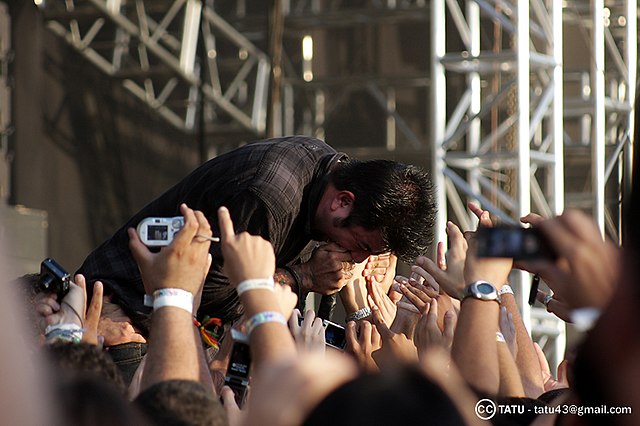Nu Metal: The Mainstream Explosion of Heavy Music
The Deftones, popular in the late 90s and early 00s, are one of many bands that are regaining popularity with today’s teens.
February 10, 2023
Have you ever gone out in public and seen shirts with funky names like Slipknot or Deftones? Or as you’re scrolling through Tik-Tok, heard songs like Change by Deftones? The shirts and songs are part of a phenomenon called nu-metal, a musical movement, and subculture that ruled over the late ‘90s and early ‘00s. This style of heavy metal has recently been getting a lot of attention on the social media platform Tik-Tok as early as 2021, and people use songs from some of these bands not knowing the legacy the bands left behind in metal.
Nu-metal is a style of heavy metal that takes inspiration from various music genres like alternative metal, grunge, alternative rock, hip-hop, hard rock, and funk. It started as far back as the mid-90s when the “Godfathers” of nu-metal, Korn, arrived on the scene with their self-titled debut album which came out in 1994. With their down-tuned guitars and riffs from guitarists Head and Munky, harsh vocals from frontman Jonathan Davis, slap bass from bassist Fieldy, and dark atmosphere, they were ready to change heavy music forever.
Early Development (1994-1999)
Along with Korn, an early wave of bands arrived on the scene during the late 90s. One of these early bands was the beloved Deftones, whose debut album, “Adrenaline,” came out in 1995. The album featured raw and aggressive vocals from vocalist Chino Moreno and an aggressive sound reminiscent of 90s post-hardcore, which the underground community loved. Deftones displayed a more developed and experimental sound on their later albums, 1997’s “Around the Fur” and 2000’s “White Pony.”
Limp Bizkit also arrived onto the early scene when in 1997, they released “Three Dollar Bill, Y’all,” which displayed hip-hop-style vocals from frontman Fred Durst and one of the earliest uses of a DJ in the genre with former House of Pain turntablist, DJ Lethal. The band later became known for their next two albums, 1999’s “Significant Other” and 2000’s “Chocolate Starfish and the Hot Dog Flavored Water,” and an incident at Woodstock ‘99, where they accidentally started a riot that resulted in 24 deaths and over 200 injuries. Despite Woodstock, the band’s album sales were not affected.
Another band from this era was the wacky and chaotic System of a Down. They released their self-titled debut in 1998, which displayed chaotic vocals from frontman Serj Tankian and intricate lead guitar work from guitarist Daron Malakian. They then became one of the most beloved bands of the ‘00s when they released their second album, 2001’s “Toxicity,” which is considered their best work.
One more band that’s recognizable from this early era is the one and only, Slipknot. They debuted in 1999 when they released their self-titled debut, which displayed very aggressive vocals from frontman Corey Taylor, and one of the first-ever mainstream use of blast beats from drummer Joey Jordison. They instantly became a success when they performed at Ozzfest ‘99. They later developed a dedicated fanbase and spawned classic albums like 2001’s “Iowa” and 2004’s “Vol. 3: The Subliminal Verses.”
Other recognizable bands from this early wave include Coal Chamber, Godsmack, Staind, P.O.D., Static-X, Sevendust, Orgy, Dope, Powerman 5000, and Snot.
Other bands that didn’t garner as much attention as the other bands but got popular later on include Spineshank, Cold, Soulfly, Mushroomhead, and Hed PE.
Mainstream Boom (2000-2003)
With the dawn of a new millennium, the bands previously mentioned maintained mainstream success, and a couple of new bands popped up. One of those bands was Linkin Park; when they came out with their explosive debut, “Hybrid Theory,” in 2000, everyone and their grandma knew who they were. The album spawned singles like “In The End” and “Crawling,” which made the album one of the best-selling albums of the century. Secondary vocalist Mike Shinoda reflected on hearing the news of the album’s success in an interview on Wall of Sound: “…They told us that the album was the best-selling album in the world, is what our manager said, and we were like ‘Oh yeah, like in the world.’ He’s like, ‘no literally in the world, it’s the biggest selling best selling album on the planet,” The band proved that they were here to stay when they released 2003’s “Meteora,” which helped them maintain the success they had achieved with “Hybrid Theory.”
One other band that established itself as an instantly recognizable band was Disturbed. The band released its debut album, “The Sickness,” in 2000 and spawned “Down With the Sickness,” which became a cult classic and helped the band skyrocket into the mainstream. The band later became well respected and blew up again in 2015 when it released a cover of Simon & Garfunkel’s “The Sound of Silence,” which proved they still got it after all these years.
Another band that became as well known as the previous two was Evanescence, who released their debut, “Fallen,” in 2003. They had a more gothic tone thanks to frontwoman Amy Lee’s theatrical singing. Their single “Bring Me To Life” became their most well-known song and was loved by many. The single later won them a Grammy for best hard-rock performance in 2004.
The band Mudvayne also became well-established in the genre when they released “L.D. 50” in 2000. They displayed a more progressive style in their sound that made them stand out due to the complex bass work from Ryan Martinie, the band’s bassist. The band later released 2002’s “The End of All Things To Come” and 2005’s “Lost and Found,” their most mainstream album to date.
There were also a couple of “One-hit-wonder” bands. These include Papa Roach, Alien Ant Farm, Trapt, Drowning Pool, Crazy Town, and Saliva.
Other bands from this era include Kittie, Ill Niño, Nonpoint, Soil, TRUSTcompany, Flaw, Taproot, and Adema.
Decline and Revival (2003-Now)
Nu-metal started to decline from 2003 to 2005 when a few bands deviated from the genre due to oversaturation and media assassination. Remnants of it lived on in bands like Chevelle and Breaking Benjamin, who weren’t entirely nu-metal but had some elements of the genre in their music. The decline eventually made room for metalcore bands like Killswitch Engage and As I Lay Dying to shine and become the dominant metal genre of the mid to late 2000s. There was also the post-punk revival going on with bands like The Strokes and The White Stripes bringing indie music back to the mainstream crowd. And surprisingly, third-wave emo or emo-pop bands like My Chemical Romance and The Used also squeezed into the spotlight and became multi-platinum bands.
Zooming to the ‘20s, something interesting happened; creators on Tik-Tok started using songs from nu-metal bands in their videos. An example of this phenomenon was the use of Deftones’ “Change,” which caused the song to blow up from late 2021 to early 2022; This also happened with Korn, Slipknot, System of a Down, and Kittie. Another contributor to this revival is this new wave of metalcore bands like Motionless In White, implementing nu-metal elements into their sound. There are also trap metal rappers like Ghostemane and Scarlxrd taking inspiration from the genre and implementing it into rap. One last contributor to this revival is the Sick New World festival scheduled for May 13th; the lineup will feature System of a Down, Korn, Deftones, and Incubus as the headliners.
This genre of music is relatable, catchy, and fun. It gets the crowd going at shows or events, and a lot of it is what people expect what heavy metal sounds like. If you ever get the chance to talk to anyone who likes metal, you’re going to expect these bands to be mentioned at least once in conversation.
Bands to check out
For those new to the genre:
Korn, Slipknot, Deftones, System of A Down, Limp Bizkit, Linkin Park, Evanescence, Disturbed, Papa Roach
For those who are already familiar with the genre but want more than just the surface area bands:
Coal Chamber, Static-X, Mudvayne, Dope, Godsmack, Staind, P.O.D., Sevendust, Saliva, Drowning Pool, Alien Ant Farm, Trapt, Crazy Town, Kittie, Powerman 5000
For those who want more obscure bands:
Soulfly, Mushroomhead, Orgy, Snot, Spineshank, Otep, Taproot, Earshot, Ill Niño, Adema, Soil, Flaw, Nonpoint, TRUSTcompany, Cold, American Head Charge, (Hed) P.E., Nothingface, Motograter, Skindred, the Union Underground, Element Eighty, Primer 55, Dry Kill Logic, 40 Below Summer, Unloco
Bands that sound similar to the genre but aren’t part of it:
Incubus, Skillet, Sugar Ray, Hoobastank, Mindless Self Indulgence, Rammstein, Flyleaf, Shinedown, Finger Eleven, 12 Stones, Chevelle, Breaking Benjamin, Puddle of Mudd, Thousand Foot Krutch, Stone Sour, Red, A Perfect Circle, Three Days Grace, Seether, Guano Apes, Zebrahead, Tantric, Deadsy, Jack Off Jill, Filter, Stabbing Westward, CKY, Glassjaw, Chimaira, Celldweller, Karnivool, Smile Empty Soul, Damageplan, Demon Hunter, Finch, 36 Crazyfists, Ra, Blindside, Orange 9mm
Bands that inspired nu-metal:
Nirvana, Faith No More, Rage Against the Machine, Anthrax, Helmet, Smashing Pumpkins, Type O Negative, Alice In Chains, Biohazard, Pearl Jam, Pantera, White Zombie, Refused, Tool, Soundgarden, Red Hot Chili Peppers, Skinny Puppy, Stone Temple Pilots, Jane’s Addiction, Sepultura, Hole, Suicidal Tendencies, Killing Joke, Infectious Grooves, Nine Inch Nails, Mother Love Bone, KMFDM, Swans, Fear Factory, Quicksand, Primus, L7, Screaming Trees, Therapy, Prong, Ministry, Mr. Bungle, Life of Agony, Melvins, Living Colour, Body Count, Hum, Godflesh, Rollins Band
Nu metal revival bands:
Spiritbox, Tallah, Tetrarch, Loathe, Vended, Jinjer, Spite, Fever 333, Nova Twins, Code Orange, Dropout Kings, Cane Hill, Death Blooms, Ocean Grove, Vein.FM, From Ashes To New, VCTMS, Alpha Wolf, Infected Rain, Fire From the Gods, Sylar, Sworn In, Blood Youth, Hacktivist, Afterlife, UnityTX, Ded, Jynx, the Gloom In the Corner, Diamond Construct, Sleep Waker



Tom • Feb 13, 2023 at 10:06 am
Very informative….well written article!
Ruth • Feb 12, 2023 at 8:10 am
Well written and a lot of research!
Jackie Pritz • Feb 11, 2023 at 9:05 pm
This was a very informative article. I was not familiar with nu metal and this mini metal education was very interesting! Thank you Matthew Pritz …well written.